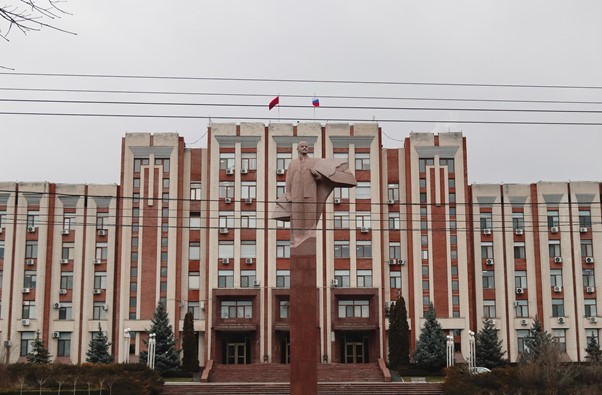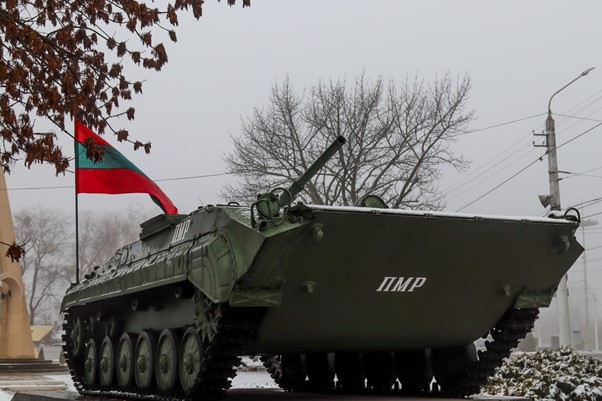Right after the dissolution of the Soviet Union, the newly-established Republic of Moldova saw a territorial change of its own with Transnistria, a pro-Russian separatist region in the West of the country trying to break out and seek independence.
This move was followed by the Transnistria war that lasted until 1992. Initially, when the war started in 1990, Russia adopted a policy of neutrality. Two years later, however, the fighting escalated and the nature of Russian engagement changed into active participation in combat. Eventually, the war ended with a Russian-backed ceasefire agreement and Russia began a peacekeeping operation in the region, which essentially meant it decided to keep its soldiers there.
Since the end of the war, Transnistria has been developing strong political and economic ties with Russia and Putin has been offering financial and military support to the breakaway state.
As of 2019 the Operational Group of Russian Forces in Transnistria numbered 1500 troops.
Over the years, Moldova and international structures such as NATO repeatedly urged Russia to withdraw its troops from Transnistria but the country has been refusing to do so.
Having its soldiers in Transnistria allows Putin to indirectly affect policies in Moldova and to slow down its integration with the European Union.
For Moldova to be able to boost its economic and political development, getting closer to being accepted into the EU, Russian troops must leave Transnistria.
Moldova chooses the EU, but Transnistria supports Russia
‘Moldova wants to become a member of the EU one day,’ said Maia Sandu, the country’s current President.
In recent years Moldova has entered into close economic cooperation with the organisation, which resulted in the EU and Moldova signing the Deep and Comprehensive Free Trade Area (DCFRA) part of the Association Agreement in 2014. That triggered lower tariffs and faster customs procedures, which resulted in increased exports from Moldova to EU member states. Now, the EU accounts for more than fifty per cent of Moldova’s total trade.
In addition to gradual economic integration, Moldova has also been working on advancing political cooperation with the EU. For instance, Moldova is covered by the European Neighbourhood Policy, designed to promote democracy, drive social development, and increase stability in countries located to the east and south of the EU territory.
Despite Moldova’s pro-European ambitions, its society remains divided between those who want to pursue European integration and those who want to get closer to Russia.
In Transnistria especially, people hope to one day be annexed by Russia so developing ties with the EU is not in their interest. And sadly, as long as Transnistria dreams of a Russia-aligned future, Moldova will not be able to push for EU membership.
Putin is blocking Moldova’s integration with the West
Even though for the time Russia’s unification with Transnistria is unlikely, Putin refuses to give up his influence in the breakaway state. Having his troops there and offering economic and political support to Transnistria allows him to have a certain degree of control over Moldova.

One of Putin’s greatest ambitions is to prevent the expansion of NATO, especially with regard to Eastern states.
Moldova’s constitution guarantees the country’s neutrality, which is why Moldova has no intention of joining NATO. But still, it cooperates with the alliance and, as NATO reports, ‘seeks to draw closer to Euro-Atlantic standards and institutions.’ That is not very much to Russia’s liking. Neither is Moldova preferring to sign trade agreements with the EU rather than joining Russia’s Eurasian Economic Union.
As Putin aims to shift Moldova’s political strategy from pro-European to Eurasian, he would not use force to annex Transnistria but instead will continue strengthening ties with the separatist republic, making it increasingly dependent on Russia’s assistance.
In an interview with Reuters, Maia Sandu, current President of Moldova said ‘unfortunately, we do still have the Russian troops on our territory.’ She also added that ‘joining the EU is Moldova’s choice.’ And yet, through making Transnistria its pawn, Russia can negatively affect Moldova’s ability to pursue wider cooperation with both the EU and NATO and the choice Sandu mentioned is at least partially dependent on Putin’s will.
It seems like not allowing Moldova to focus on fostering democracy and making the most of its freedom is an embodiment of Putin desperately holding on to the remnants of the Soviet Union. After all, in his eyes the USSR was the greatest empire the world had ever seen.
The withdrawal requires careful preparation
The withdrawal of Russian troops from Transnistria is necessary for Moldova to prosper but enabling such a scenario requires more than convincing Putin to do so.
Thanks to Russian investments and training, the Transnistrian military has grown to be stronger than the Armed Forces of Moldova.
‘Moldova counts about 6,000 soldiers in its small army, while Transnistrian military forces number between 10,000 and 15,000 soldiers. Moreover, while the Moldovan army has no warplanes or tanks, the breakaway Transnistrian army has both,’ Balkan Insight observes. Moreover, Russia frequently organises military exercises in Transnistria, making sure that soldiers based there are ready for any possibility of military action.
For Transnistria, having Russian troops on its territory means increased stability and a more professional army. Consequently, the separatist region will do everything it can to keep them there.

Then, there is the Cobasna ammunition depot, one of the largests weapons depots in Eastern Europe, containing up to 20,000 tons of Soviet-era munitions. Guarding it is the official reason for the presence of Russian troops in the breakaway state. For the withdrawal of Russian troops to be able to happen, weapons stored in the depot need to be withdrawn and destroyed. In the past, there have been several attempts to take weapons out but these were stopped by the Transnistrian government asking Russia not to give up its presence in the region.
Keeping Transnistria under Russia’s influence is a strategic move, allowing Putin to take the lead in the geopolitical competition with the EU over Moldova’s attention. Maintaining a military presence in Transnistria is one of the easiest ways for him to keep his grip on power in the region.
At this point, Russia has an established position in Transnistria so the eventual withdrawal would need to happen gradually. Forcing such a move could lead to Moldova facing a backlash from the pro-Russian population of Transnistria.
Still, just like Serbia will not be able to join the EU until it deals with the Kosovo issue, Moldova needs to find a solution to the frozen conflict in Transnistria to have a chance of making its EU dream come true.
Hence, calling for the withdrawal and preparing for it should be a priority for Moldova’s government in the months, or more likely years, to come.

